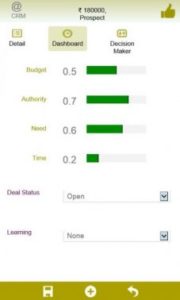What are the sales deal stages?
The sales cycle and the buying cycle
A sales cycle mirrors the purchase cycle- or it should.
The customer moves from initial awareness to interested and gets more involved in the decision making. He evaluates the solution and compares features, price and so on. Finally, he is ready with a decision.
Similarly, a sales cycle proceeds from initial sketchy understanding to deeper understanding- we learn more about the customer and his objectives, needs, how much he is prepared to spend and by when. The customer learns more about our solution as well. While this is a continuum, it is useful to create milestones to really understand how much work is still left to convert the opportunity/ deal into a purchase order. These milestones are the sales deal stages.
What makes it interesting is that, in almost all cases, you will have lesser quantity of deals in advanced stages of sales progression than at the beginning. What you lose in quantity, you make up for in quality- in being able to convert a far higher percentage of the advanced deals into orders.
Lots of names are used for the sales deal stages. Here’s what we use:

You will see many, different names being used- depending on industries, even companies- they all use their own. Here’s how Hubspot describes the lead progression stages. Let us at least tell you what ours stand for.

The 5 sales deal stages
Lead:
You have just enough information about a potential sale. Some approximate idea of the budget and initial idea of the product/ solution fit to his needs.
Budget known, At least one Decision maker identified, Budget not identified, Budget Stage not identified.
Prospect:
Now you are sizing out the opportunity. Enough to schedule a visit/ call- some task to progress the deal with the decision makers. To early to forecast the time-frame or indeed the chance of closure.
At least one decision maker identified, Budget value OR stage identified, not yet met with or discussed the solution with the decision makers, some task scheduled.
Warm Deal:
A lot more information and interaction under your belt. You have met with the decision maker (s), discussed the solution enough to report their reaction to it, have a better grip on the budget size and approval cycle. And, you can commit yourself to a forecast date (howsoever tentative) or even a chance of win (howsoever low!).
Hot Deal:
The final stage before you reach the stage of closure. At this stage, you are in possession of all the information related to the deal. You have also submitted a firm priced proposal.
This stage is also called Presentation because it is here that you are making the final solution presentation to the clients to swing the deal your way.
Closure:
Closure is often mistaken as a Win. While that may be the desirable outcome 🙂 , we take a deal closure as the stage where the deal is awarded to one of the competitors, including you!
It is close enough after the Presentation stage; so, think of this as the Presentation stage done and waiting for the result- handling last minute objections, ensuring your messages have sunk in and definitely a sales deal stage which can be forecasted to close in the next month or so.
